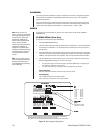
Pelco Manual C581M-B (1/04) 15
1. Select the desired multi-camera display.
2. Press and hold the multi-camera display key to enter
the multi-screen programming mode. A bar will appear
in the first camera location.
3. Use the pan/tilt keys to move the on-screen bar to the
desired camera location for sequencing, and press
sequence key to initiate the sequencing of all active
cameras.
1. Hold down the SEQ key for approximately three
seconds.
1. Follow the steps under “Run a sequence of cameras
from one multiplexer on the MAIN monitor” or “Run a
sequence of cameras from one multiplexer on the
SPOT monitor” to start sequencing the cameras on the
main and spot monitors of individual multiplexers that
you want to sequence.
2. Hold down the SEQ key for approximately three
seconds to start sequencing the multiplexers.
1. Press the
key.
2. Press the SEQ key.
Press a pan/tilt key or select any camera.
Program the monitor in the Advanced System Setup
menu.
Table B. Operation Guide (Continued)
Starts sequencing the multiplexers
in numerical order, displaying the
main monitor first, then the spot
monitor. Monitors to be displayed
are selected in the Set Sequence
submenu of the Monitor menu of
the server. As each monitor is
displayed, it sequences.
Sequencing appears on the
monitor affiliated with the key-
board; for example, if the keyboard
is set for address 1, the sequence
will appear on monitor 1.
Sequences all active cameras in
the PIP display.
OPERATION KEYBOARD COMMAND RESULT
(Continued on next page)
Stop a sequence of
multiplexers.
Call a camera or run a
sequence of cameras
on the AUX monitor
(duplex multiplexer
only).
Sequence multiplexers
connected to a server
and sequence cameras
on a multiplexer(s).
Sequence the PIP
display.
Sequence stops.
Monitor responds to programming
instructions.
Starts sequencing the multiplexers
in numerical order, displaying the
main monitor first, then the spot
monitor. Monitors to be displayed
are selected in the Set Sequence
submenu of the Monitor menu of
the server. Sequencing appears on
the monitor affiliated with the
keyboard; for example, if the
keyboard is set for address 1, the
sequence will appear on monitor 1.
Sequence multiple
cameras in one
location of a 4-, 9-, or
16-camera display.
Sequence multiplexers
connected to a server.
The sequence will run until the
sequence key is pressed or until
another camera or multi-screen
display has been selected.


















